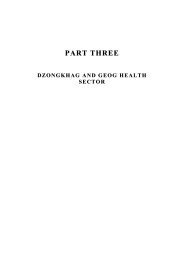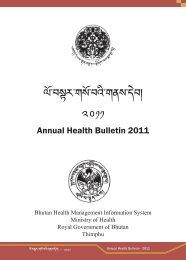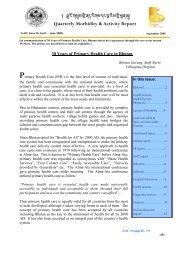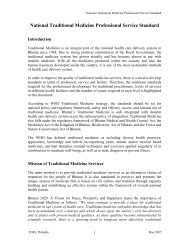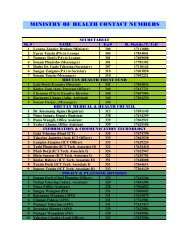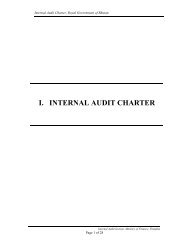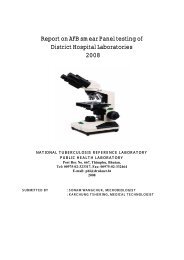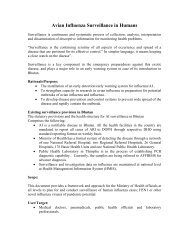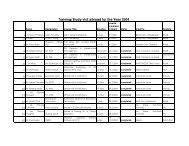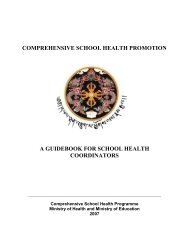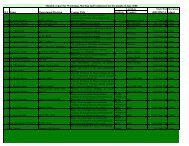ANNUAL HEALTH BULLETIN 2004 - Ministry of Health
ANNUAL HEALTH BULLETIN 2004 - Ministry of Health
ANNUAL HEALTH BULLETIN 2004 - Ministry of Health
Create successful ePaper yourself
Turn your PDF publications into a flip-book with our unique Google optimized e-Paper software.
History<br />
In the 1990s, radio telephonic linkages were established in order to connect the remote<br />
Basic <strong>Health</strong> Units (BHUs) and hospitals that are scattered all over the country.<br />
Telemedicine was incepted when Dr. H.Nakajima the then DG <strong>of</strong> WHO had an<br />
audience with His Majesty the King, Jigme Singye Wangchuck in 1997. It was fUlther<br />
strengthened when internet was introduced in the country in June, 1999.<br />
The Telecommunication Development Bureau (BTD) <strong>of</strong> the International<br />
Telecommunication Union (ITU) in 1999 started a pilot project on Multipurpose<br />
Community Telecenter (MCT) wherein Telemedicine was one <strong>of</strong> the components. In<br />
conjunction with the MCT project, a teleradiology project was initiated in 1999-2000<br />
by connecting the district hospital at Jakar to the Jigme Dorji Wangchuck National<br />
Referral Hospital (JDWNRH) in Thimphu. The X-Ray image and ECG image<br />
transmissions were carried out successfully, thereby, demonstrating the applicability <strong>of</strong><br />
the technology.<br />
In November 2000, the two major referral hospitals at Mongar in the east and the JDW<br />
in the west were connected. Consultations in different fields <strong>of</strong> specialties like<br />
Radiology, Dermatology, Medical, Orthopedics, Surgical, Pediatric, Psychiatry,<br />
Pathology etc. were carried out and monitored monthly based on the consultation<br />
reports. Soon Gelephug district hospital was also connected to the internet and thereby<br />
provided with X-Ray digitizer and digital camera to carry out necessary telemedicine<br />
consul tations.<br />
In March 2003, the East Bhutan Tele-ECG' project was carried out in close<br />
collaboration with the Tokai University <strong>of</strong> Medical Sciences, Japan through the<br />
Japanese grant for Grassroot Projects (GGP). Necessary trainings were provided with<br />
support <strong>of</strong> the TeIemedicine Society <strong>of</strong> Japan (TSJ). The Trashiyangtse and Lhuentse<br />
sites were provided with multipurpose equipment with analyzer s<strong>of</strong>tware for ECG,<br />
Cardioechogram and Phonocardiogram. The connection bi:l ween these two hospitals<br />
and the referral hospitals is done through the dial-up connection via the local PSTN.<br />
Since there are only one cardiologist in the country, the doctors from these two sites<br />
consulted cases to the APT 2 nd Opinion Center housed in Tokai University, Japan for<br />
correct and prompt diagnosis.<br />
Inorder to monitor and guide the development <strong>of</strong> the project, a <strong>Health</strong> Telematics<br />
Taskforce was formed in April 2000 with personnel from the <strong>Ministry</strong> <strong>of</strong> <strong>Health</strong>,<br />
hospitals and WHO country <strong>of</strong>fice under the chairmanship <strong>of</strong> the Director <strong>of</strong><br />
Department <strong>of</strong> Medical Services. It has been further strengthened with members<br />
included from the <strong>Ministry</strong> <strong>of</strong> Information and Communication and other relevant staffs<br />
from the <strong>Health</strong> <strong>Ministry</strong>.



